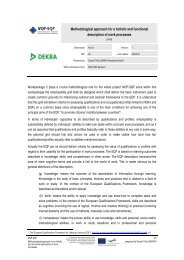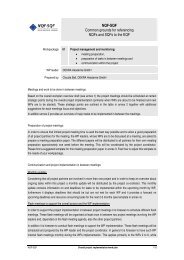Overview of National Qualification frameworks - Project-Nqf-Sqf
Overview of National Qualification frameworks - Project-Nqf-Sqf
Overview of National Qualification frameworks - Project-Nqf-Sqf
You also want an ePaper? Increase the reach of your titles
YUMPU automatically turns print PDFs into web optimized ePapers that Google loves.
__Hotelfachschule, Tourismusfachschule, Gastgewerbefachschule (medium-level secondary colleges for hotel management,tourism, catering; three-year courses)__Fachschule für Sozialberufe (medium-level secondary college for social workers): three-year __Fachschule für Sozialberufe(school for social workers), Schule für Sozialdienste (school for social services, two years)__Land- und forstwirtschaftliche Fachschulen (medium-level secondary ag-ricultural and forestry colleges; length <strong>of</strong> trainingbetween two and four school years)__Schulen für Gesundheits- und Krankenpfl ege (schools for health and nursing services, age <strong>of</strong> admission 16 or 17).Secondary Technical and Vocational Colleges (BHS or Berufsbildende höhere Schulen)In addition to providing in-depth general education, over a period <strong>of</strong> fi ve years berufsbildende höhere Schulen (BHS) givestudents an advanced vocational train-ing, culminating in a Reife- or Diplomprüfung (matriculation or diploma exam). Thisentitles them to admission to university, higher technical colleges and post-secondary colleges. Universities and highertechnical colleges are required by law to give students credit for specialized knowledge acquired by BHS graduates.Once they have worked in their fi eld for three years, graduates <strong>of</strong> most höhere technische and höhere Land- andforstwirtschaftliche Lehranstalten (higher-level secondary industrial, agricultural and forestry colleges) may apply to the FederalMinistry <strong>of</strong> Economics and Labour or the Federal Ministry <strong>of</strong> Agriculture, Forestry, Environment and Water Management forauthorization to use the pr<strong>of</strong>essional title <strong>of</strong> "lngenieur".The most important higher-level secondary technical and vocational colleges:__Höhere technische and gewerbliche Lehranstalten (higher-level secondary industrial and trade colleges)Höhere Lehranstalt für Mode, für künstlerische Gestaltung, für Produktmanagement und __Präsentation, Modedesign undProduktgestaltung (higher-level secondary college for fashion, artistic design, product management and presentation, fashiondesign and product design)__Höhere Lehranstalt für Tourismus (higher-level secondary college for tourism)__Handelsakademie (higher-level secondary commercial college)__Höhere Lehranstalt fur wirtschaftliche Berufe (higher-level secondary college for occupations in the food and beverageindustry)__Höhere Lehranstalt für Land- und Forstwirtschaft: (higherlevel secondary college for agriculture and forestry)__Bildungsanstalt für Kindergartenpädagogik (kindergarten teacher-training college)__Bildungsanstalten for Sozialpädagogik (teacher-training colleges for social education)Educational Courses after MatriculationThe qualification for admission is Reifeprüfung (matriculation exam), Berufsreifeprüfung (vocational matriculation examination)or an entrance examination.Kollegs (specialised post matriculation courses): These are two-year full-time (or two to three-year part-time) advancedlevel vocational courses equivalent to higher-level technical and vocational colleges.Post-secondary colleges__Training 1: Public and private post-secondary colleges train teachers for positions at primary schools (including pre-school),general secondary schools and special schools, as well as polytechnic colleges.__Training 2: Some public post-secondary colleges train teachers for positions at vocational colleges, for technical/trade areas<strong>of</strong> specialization, for the specializations <strong>of</strong> design and nutrition, and to teach information and communication at BMS or BHScolleges.__Training 3: The college <strong>of</strong> agricultural and environmental pedagogy <strong>of</strong>fers training for positions at agricultural and forestryvocational colleges and technical colleges as well as for positions in agriculture and environmental studies at higher agriculturaland forestry colleges.__Training 4: Private pedagogic colleges and several private institutions train religious instruction teachers (Catholic,Evangelical, Old Catholic, Orthodox, Eastern Orthodox, Islamic, Jewish) at compulsory schoolsUniversities <strong>of</strong> Applied Sciences (Fachhochschulen)Scientifi cally grounded vocational training with a strong practical orientation (usually one semester <strong>of</strong> vocational experience).The following types <strong>of</strong> courses are currently <strong>of</strong>fered:__Diplomstudien (diploma courses): generally last 8 semester (4 years) and conclude with the academic title <strong>of</strong> "Mag. (FH)” or“Dipl.-Ing.(FH)”. Diploma courses are gradually being replaced by Bachelor’s courses or continuation study on Master’scourses.__Bachelorstudien (bachelor’s degrees): generally last 6 semesters (3 years) and conclude with the academic title <strong>of</strong>“Bachelor”. In some subjects, particularly in the area <strong>of</strong> social work and health services, graduating also entitles you to practisethe relevant vocation (e.g. social worker, physiotherapist).__Masterstudien (master’s degrees): are a continuation <strong>of</strong> bachelor's courses, and are designed primarily for the purpose <strong>of</strong>obtaining an additional scientifi c grounding; they generally last 4 semesters (2 years) and conclude with the academic title <strong>of</strong>"Master”.NQF-SQF:"This project has been funded with support from14/15<strong>Overview</strong> <strong>of</strong> <strong>National</strong> <strong>Qualification</strong>prepared by 3s research laboratory<strong>frameworks</strong>the European Commission. This publicationreflects the views only <strong>of</strong> the author, and theCommission cannot be held responsible for anyuse which may be made <strong>of</strong> the informationcontained therein."




